I’ve known Mike Norton for about 13 years now. I met him when I was 14 at one of the first years of New York Comic Con, where he gave me what is still my favorite sketch I’ve ever commissioned. Even though I wouldn’t be a journalist for a number of years, he always recognized me. He was more on the fringes of the Big Two at the time, coming up with Sean McKeever to work on books like Gravity at Marvel and Green Arrow at DC.
After a few years, he returned to creator-owned, completing an epic 47-issue creator-owned series and taken on a variety of interesting projects, including his own webcomics Battlepug and Li’l Donnie. I was excited to speak with him about a myriad of subjects, including his current workload, the state of commissions, making a beloved webcomic he is eager to quit, and so much more.
You have so many different projects going on. How do you juggle them all?
Something I’ve come to realize lately is that I’m not as good at juggling the projects as I used to be. I tend to stagger stuff, so I’m pretty good at making sure that when I’m not working on one thing I’m working on something else. The last six months to a year has been more difficult. I haven’t been as focused or as fast at as I used to be.
Usually, it’s just a matter of scheduling things so that deadlines don’t overlap too much. It’s a lot of smoke and mirrors honestly that makes it look like I’m doing a lot more than I am. But lately I’ve slowed down. But you’d be surprised at how much stuff you get done when you [stay busy while] things are being approved and stuff like that. You just work on something else in the downtime.
So that’s how it managed to last seven years [at this rate of output]. But I’m getting old, getting tired.
Even if you’ve slowed down you’d still be faster than the vast majority of the artists working in comics.
Sure, but a lot of them are more popular than me. [Laughs] They’re doing something right. They don’t have to do multiple projects; they’re doing pretty good on their own.
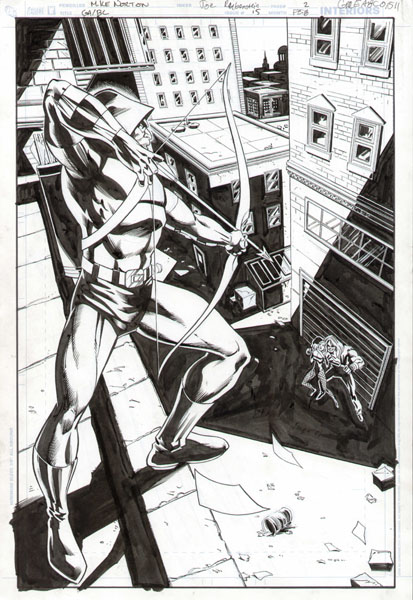
I’m just surprised that someone like Jim Cheung can make a living doing on average like five pages a month.
Bottom line is they can just quit tomorrow and go to conventions and make thousands of dollars, but they keep doing comics because they love them.
Yeah, I’ve seen his prices and the rate of other huge artists and they’re insane.
I’m glad they’re still doing comics because that’s what I prefer to see. I think Jim Cheung is amazing, he’s one of my favorites. Jim Cheung, Art Adams, Oliver Coipel, I love all those guys. They do things on their terms because they know that audience will be there.

Some great artists seemed to have abandoned comics altogether to do solely commissions.
A lot of artists I know who end up doing commissions just don’t enjoy the scheduling of doing a comic. For them, it’s more fun to do [a few detailed pieces a month].
And it must pay so much better.
I’ve never tried it before because I don’t have original artwork since I do everything digitally.
My art dealer has really got on my case about doing commissions. I don’t know how well I would do, but I usually don’t do commissions because I’m so busy working on comics.
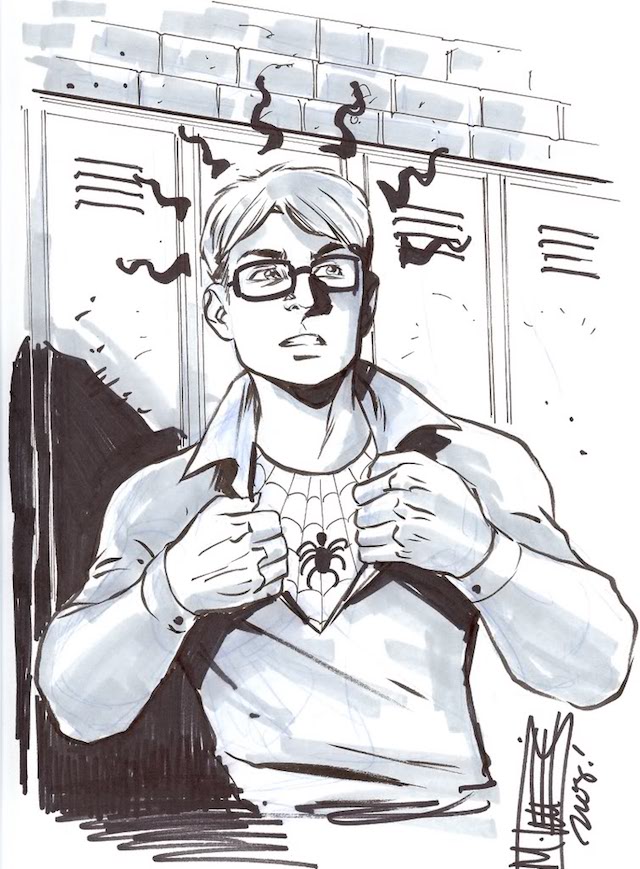
Your prices at conventions are really affordable, staying at around $40 or $50 dollars for a sketch.
I’ve had I’ve had other pros complaining about that. I do it just because I feel like I’m not Jim Cheung, you know?
I price my stuff what I’m comfortable selling it for, and based on how much work I actually want to do at a particular show. So if I don’t want to do [very many sketches] I might make them more expensive. But I’ve been doing okay. Plus I don’t keep any of the earnings shows anymore.
Right, you give it to charity now.
Basically, I’m giving it to organizations that are helping people. I started out because of the Trump thing and now I’m just trying to pick up the slack for the stuff that he’s cutting. So the last year or so all the convention money has gone to those types of programs. But it sounds a lot better on paper because sometimes I don’t make any money at shows. But anytime I do make a profit it goes to those places.
Still, that’s great. Speaking of Trump… I wouldn’t ordinarily open with this type of question, but, given the subject material, what’s the worst part of making Lil’ Donnie?
The worst part of making Lil’ Donnie is making Lil’ Donnie. It’s a grind at this point. I started out almost exactly a year ago and I was so fired up.
I was so angry and, being a fairly well off straight white male, I didn’t really know what else I could do other than giving money which I’m doing now. And [another way I’ve found to contribute] is publicly make fun of Trump through the webcomic.
And now I’m just sick and tired of it. I just wish he would go away.I started this thing and now I have to finish it. And if there’s anything that I’m proud of myself for it’s that I finish stuff, God help me.
How do you define finishing the webcomic?
I want to outlast him. I want to be here after he is gone. And that’s a really dumb rule I put on myself. I’m really upset about it and don’t like myself anymore.
[Laughs] So it feels important to continue doing it?
Yeah, that’s the only reason I’m still doing it. I don’t find it fun. I mean I enjoy coming up with jokes under a constraint. That’s a very interesting and creative exercise.
Yeah, it’s like a writing prompt. I think it can lead to better output. Like how Tom King, who I know you just worked with, asked for DC to give him a title to work on and they chose Mister Miracle, which is already this instant classic.
I think that’s the strength of comic books. My chosen field is generally working under a constraint. It forces you to be creative I’ve always felt that shows like Doctor Who in the early days when it was extremely constrained by budgets, they come up with these extremely creative ways to get around budgets.
I feel like that’s the thing was with comics. You can come up with lots of stuff, but you’re [limited by] time. It’s about how much you can get done within 30 days. And with Lil’ Donnie that and making fun of Trump was the appeal that made me fired up. And I still am. But I’m so sick and tired of the guy that I just don’t want to do it anymore.
All cards on the table, I was looking into the Eisner Awards and found out that Lil’ Donnie isn’t even eligible. And I’m like, well why the hell am I doing this anymore?I can’t even get any kind of recognition for it, but that’s not why I’m doing it. I’m doing it for the pettiest of reasons and that’s to make fun of somebody and I win when he’s gone and I’m still making fun of him.
You mentioned being angry. It gets really tiring being angry all the time.
Yeah, it’s so tiring. That’s why any psychologist will tell you to stop being angry [laughs].
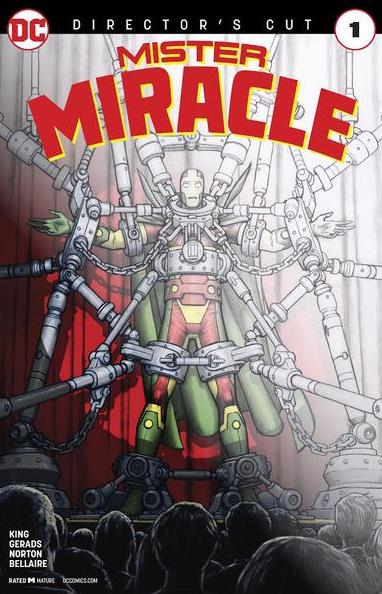
You’re drawing a backup story in Mister Miracle. Is it exciting being a part of something that is already an instant classic?
Yeah, I’m very lucky. I read that book and I thought it was great even though I didn’t know what was going on in it. Usually, if I think something’s too far off the reservation I won’t like it, but this was really this caught me in a similar way LOST did.
So I was getting it and the writing and artwork from Mitch Gerads were really drawing me in. I told Tom at a convention he should make a whole issue out of the TV show Scott Free is watching in the hospital room in the comic and he asked if I wanted to draw that […], so we basically did a retelling of the Mister Miracle origin in the format of the TV show that Scott watches in the hospital while he’s recovering from his suicide attempt.
Are you drawing in the 9-panel grid format like Mitch is?
I’m drawing on a 6-panel grid. And the Mister Miracle Team is very adamant that I stick to it. In fact, I tried to go and do something different and the editor Jamie S. Rich and Tom both came down on me and said no, no, we’re trying to do a thing here. So I had to go back and redraw a couple of pages because they definitely had something in mind.
It’s fascinating the flow the grid format gives you. You don’t get the same thing when you leave the panel layout more up to the artist’s whims.
Yeah, that’s the thing. There are writers put something out there and want the artist to figure this out, but Tom definitely has something in his head while he’s writing. He knows what he wants
It really depends on the creative partner for whether or not that pans out. Sometimes an artist doesn’t want to go that way, give up that much freedom. As long as I know before I go in then I think that’s great. My favorite parts of comics are drawing the quiet moments of people acting and the collaborative effort. I really like seeing what happens when half an idea gets passed on to another person I really think that’s exciting.
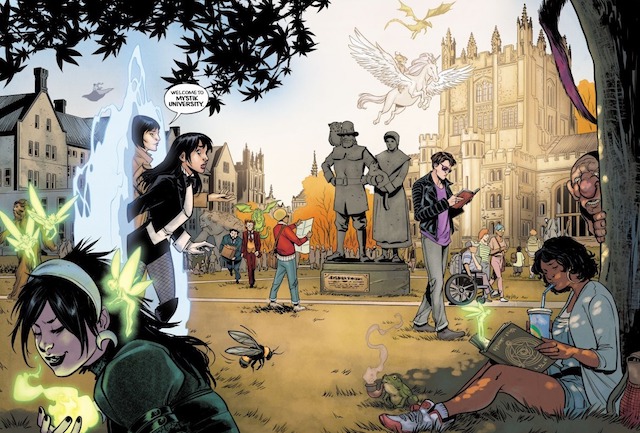
Mystik U has been your most recent big project. Was it always going to be three issues?
Yeah. They came to me and had the idea for a prestige series were definitely into this whole new young adult style of storytelling. They wanted to make these huge issues so when is said and done it will still be a standard trade paperback’s worth of material.
But it has always been three issues, and it meant having to do more on the front end but that’s fine. And it was definitely more in my wheelhouse. It’s all younger characters and a lot of interpersonal relationships rather than focusing on people punching each other in the face.
For a long time, you were typecast as the guy who draws teenagers.
Yeah, I don’t mind that.
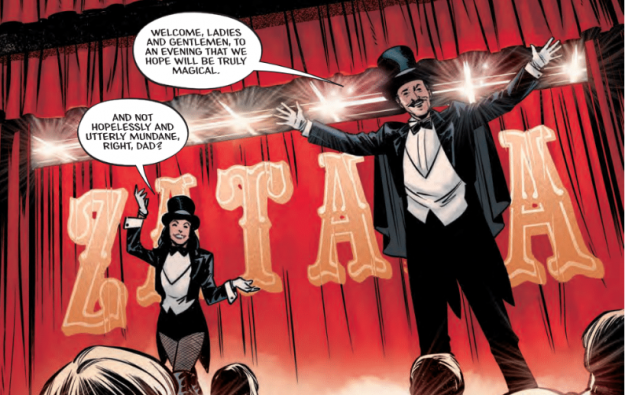
Oh, okay. I was wondering if you were hesitant to return to it but I guess not.
No, I like it. I like drawing people talking to each other people.
It’s definitely my favorite thing in every medium.
It’s hard to draw, hard to make that look interesting. I started out drawing teens talking in snow [in The Waiting Place]. Then both Sean [writer of The Waiting Place] and I moved on to writing and drawing and people punching each other in New York. And that was more difficult for me. I like doing it but it not… It’s weird because that’s what I grew up reading and all I ever wanted to do. But it’s not second nature to me. I don’t know why that is. I still love doing it. It’s just not what I think I’m the best at. Something like Runaways is the perfect combination of those two kinds of stories
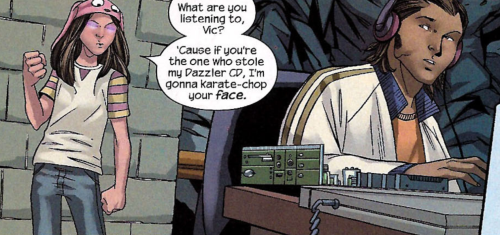
Are you reading the current series?
I haven’t yet.
It’s so good.
I’ve seen some of the artwork. I like what Kris [Anka] is doing in it.
It’s really great. First writer that’s captured the Runaways since Brian K. Vaughan, in my opinion.
I’m glad. I know that Joss and Terry tried but it wasn’t exactly… I think they went too far, which feels funny to say. I think they went too weird. But yeah, Brian’s is obviously the ultimate. But I’ll read this one. It’s by a young adult novelist?
Rainbow Rowell, yeah. I’ve never read any of her books but she’s clearly perfect for Runaways.
Wow. I’ll check it out eventually. I know I need to. I love Runaways.
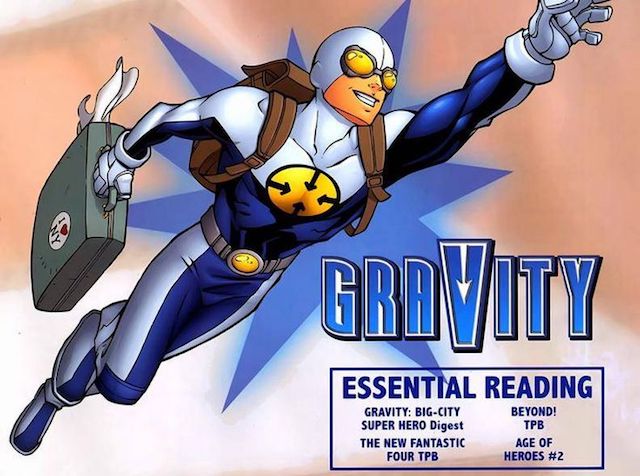
I know you and Sean McKeever are doing a book together. Can you talk about that?
Sure. We started working on it about a year ago. I have about half an issue finished because I keep taking on paying projects. But it’s a book about teens, obviously, that’s what we do. It’s called The Undead. A team of kids died but they want to still save people. So they have this mysterious benefactor that is helping them save people still alive. It’s sort of inspired by things like The Dead Boy Detectives, New Mutants, that kind of thing.
I’ll get it done at some point. I don’t know how it will come out, whether it’ll be an Image comic or Kickstarted, or [released online]. We’ve discussed all different distribution paths. I know I’ll finish it at some point because of Sean is like a brother to me.
We work well together and I balance out his kinks. He has like a moroseness to his writing that I feel like I’m a good counterbalance to. So I think we make perfect teen comics even though we’re both in our 40’s. I mean that’s what being a teen is being, you know, a depressed person. So yeah I think we [continue to] tap into that pretty well.
Do you have a plan for how long The Undead is going to go?
So we’ve only planned so far six issues. It could be longer than that, but nowadays I always assume everything is a mini. I hear some announcements from Marvel or DC about new series, and figure they will be over after one arc.
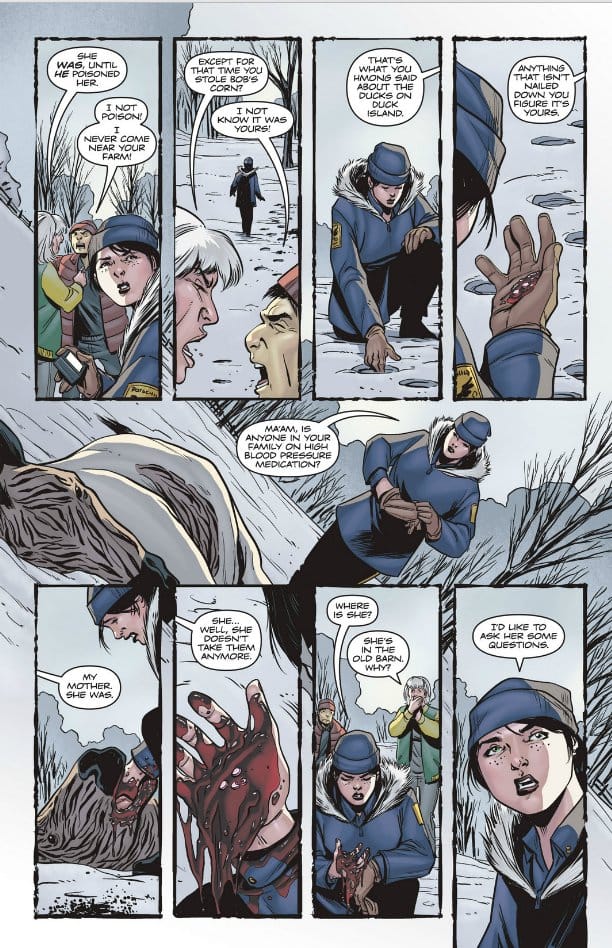
Right. Even series from big name creators are becoming 30 issues instead of 60. It’s crazy how the market has transformed
Yeah, it’s different now. I’m not really a big picture guy when it comes to looking at sales figures, but I do know what I like, I do know want I read, and I do watch trends. People are obviously trade waiting and more interested in completed stories. There are the diehards still excited by the serialized stuff, they’re who are keeping Marvel and DC afloat.
But most people are into finished stories. And that makes it easy to hop off of a regular series. With Revival, sales went down as it kept coming out, like with any comic, but we had a story we wanted to tell and even if it had started losing money we still would have still put it out until we were done.
And a long ongoing series is an investment, a revenue source for the money you’ll still be making hopefully twenty years from now.
We’re still selling trades and hardcovers of Revival because that’s how people buy something like it now. And was how it was intended [to be read]. People consume entertainment in a different way now than they did just five or ten years ago. So my job is to keep an eye on that, but still try and come up with an interesting story. My focus is to make stuff that I like, I don’t want to be too analytical about things because then I feel like I’m starting to create for an audience. I really want to entertain myself first and foremost and then secondly I’m like, “Would anybody buy this?” But nine times out of ten if the answer is no I’ll still make it. I don’t know if that’s a good thing but nowadays I’m not going to draw something if I’m not excited by it.
Like Mystik U. I’ve never drawn magic characters and never knew much about Zatanna, but it sounded like a really entertaining project. I’m really into doing things that sound fun to me now rather than what I think Will get me a huge royalty check.
I got the sense that working on Revival and less at the Big 2 made you more desirable.
Oh geez, I hope that’s true. I haven’t seen that to be the case. I’ve made it known that I want to do more Star Wars and certain Marvel properties, but my phone doesn’t ring so I don’t know if that’s necessarily the case. I do know that working on Revival made me less desperate. I’m not as hungry to take anything that’s offered to me anymore, and I feel like that has helped me be a better creator.
That doesn’t mean that working for Marvel DC is a desperate thing and you shouldn’t do it. I loved working for Marvel DC. The first seven years of my professional career were there, and I learned so much that I would not have been able to learn anywhere else. I learned a lot about how to make a comic book from working at those two companies.
But when I started working on my own comic that I could make a living from, there wasn’t much desire to beg for work. So it changes your perspective.
To support Mike, back his Patreon, follow him on Twitter, and read Li’l Donnie since he’ll keep torturing himself by doing it regardless. Plus, it’s really funny.
Matt Chats is an interview series featuring discussions between Matt O’Keefe and a creator or player in the comic book industry, diving deep into industry, process, and creative topics. Find its author, Matt O’Keefe, on Twitter and Tumblr. Email him with questions, comments, complaints, or whatever else is on your mind at [email protected].


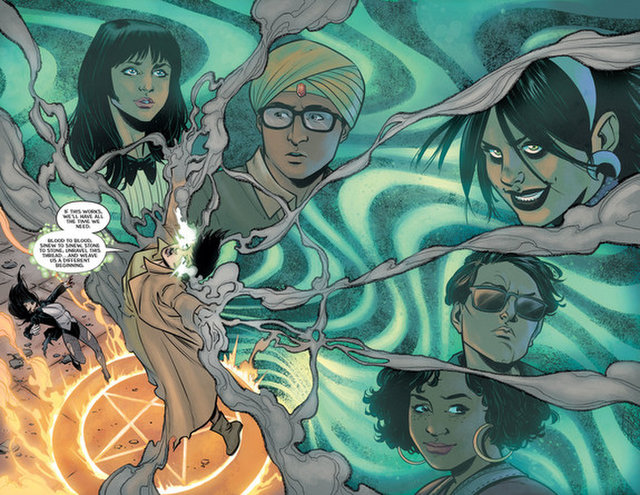
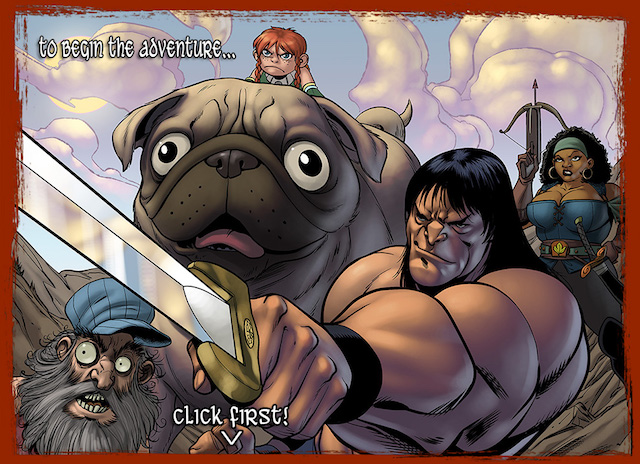
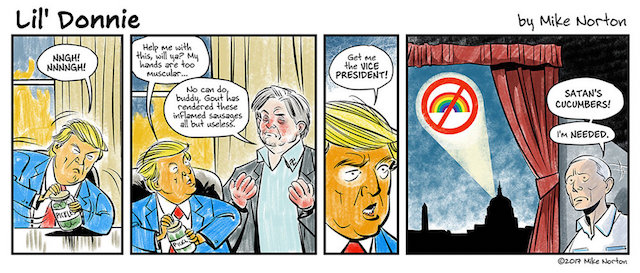
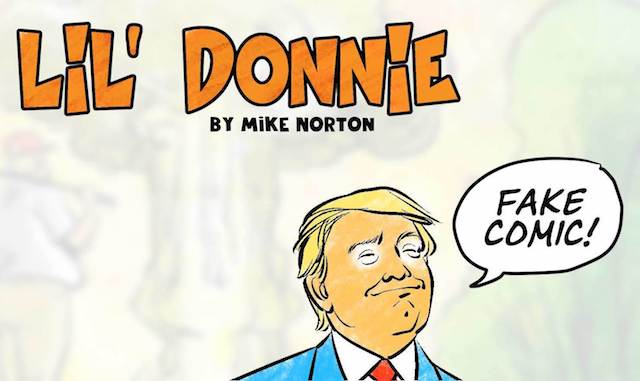
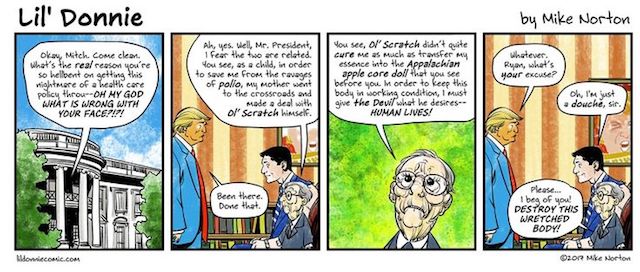



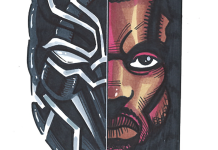


Hi, nice interview on a cool creator. The buried headline for me is Sean McKeever’s return to comics. I absolutely loved The Quiet Place and I will look over anything McKeever and Norton do together. Gravity was great, and so was McDuffie’s usage. Revival benefits greatly from Norton’s consistent class. Lot of respect for Norton, and McKeever
Comments are closed.